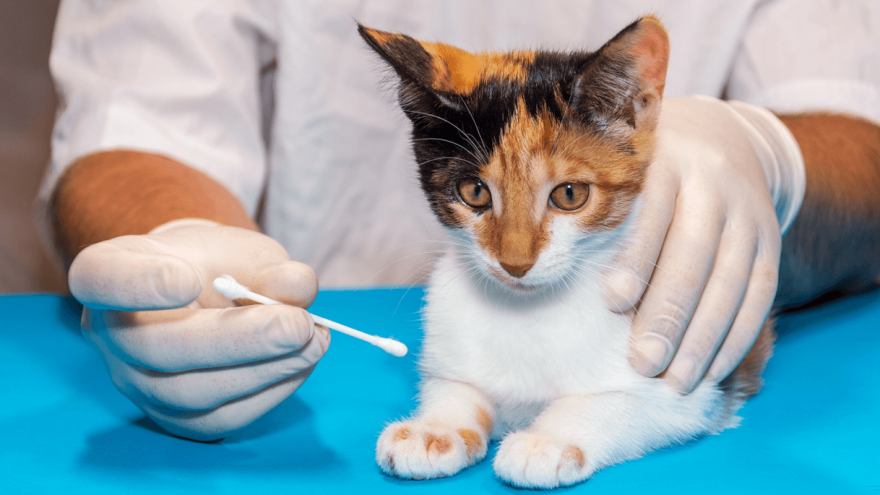Ringworm in Cats | Symptoms, Diagnosis & Treatment
21.02.2022.
One of the most essential tasks cat owners have is - parasite prevention. We need to ensure our cats are safe from different topical and internal parasites that might cause severe health complications. One of those parasites is ringworm. If you’ve noticed changes in your cat and you suspect she might have ringworm, here are a few things you should know about ringworms in cats.
What is ringworm?
The first thing we need to know is - what actually is ringworm? Its name might suggest it is an internal parasite of the worm-type, but actually, this parasite has nothing to do with worms. In fact, it is a type of fungi. Ringworm can be defined as a fungal infection of the top layers of skin, hair, and nails. It is named “Ringworm” because the infection leaves a distinct raised, red ring shape in humans. However, the shape is not always round.
One of the main concerns about ringworm infections in cats is that the species that causes the vast majority of ringworm infection cases in cats is zoonotic. That means the species that causes infection in cats, Microsporum canis, can be transmitted to humans and other pets. Some species of fungi are species-specific, which means it only infects one species of animal or human.
How can I know if my cat has ringworm?
Noticing ringworm infections in cats can be tricky. They might not have distinct round-shaped rings on their skin. However, most cat owners will notice something weird going on with their cat’s skin. Owners should notice some hair loss in their cat’s coat, which is when they’ll call the veterinarian and book an appointment. If you’re not a vet, it can be pretty hard to guess exactly what’s bugging your cat.
Ringworm symptoms in cats
Like any other health condition in cats, a ringworm infection will come with specific symptoms. Those symptoms can point the vet in the right direction and help them determine the exact cause of your cat’s condition. However, ringworm symptoms are similar to other skin issues in cats, so your vet might need more information than just symptoms. Here are the most common symptoms of ringworms in cats;
- Patches of hair loss
- Red skin
- Inflamed skin
- Scaly skin
- Infected nails
The symptoms can vary depending on the area ringworms infected.
How can my cat get infected?
Another critical question cat owners want to know the answer to is - how can my cat get infected? If we understand how ringworms are transmitted, we can prevent that from happening. As we already said, ringworm is not actually a worm; it is fungi. The only way a cat can get infected is through direct contact with infectious spores. If that happens, the cat might get infected.
Ringworm spores are pretty resilient. Some reports and researches claim these spores can survive up to 18 months on different surfaces. They can be mostly found in bowls, combs, bedding, carpet, or toys where the infected cat was moving and in the things she was using.
However, just because the cat got in contact with the spores doesn’t mean the infection will happen. A healthy feline immune system can easily fight off ringworms, especially if the cat hasn’t contacted a massive amount of spores. The biggest problem with ringworm is connected to senior and geriatric cats, cats with immune system issues, and kittens.
How is it diagnosed?
After you book an appointment with your vet, the vet will look at the cat’s clinical signs and medical history. After careful consideration, the vet will order further tests that might eliminate possible causes or show them the exact cause. In the case of ringworm infections, the first test should be Wood’s lamp examination. The ringworm should glow with a yellow-green fluorescence when examined with this lamp.
The most precise way of determining ringworm infections in cats is by performing fungi culture in the laboratory. The vet can take skin scrapings and hair samples and send them to be analyzed in the lab. However, some cultures are pretty slow to grow, so the results might not be confirmed for 4 weeks.
How is ringworm treated?
Ringworm infections are primarily treated topically with creams, ointments, and shampoos in combination with oral anti-fungal medications. These treatment options have shown the best results in the past, and vets are pretty happy to prescribe them to infected cats. One of the most important things to do is eliminate spores from the immediate environment. The cat will be contagious, and the fungus spores will fly all over the place. It is up to the owners to make sure the environment is clean and fungus-free. That can be done by vacuuming daily, cleaning the areas accessible to cats, getting rid of cat hair, and using a solution of chlorine bleach and water.
World Cat Finder Team







Share